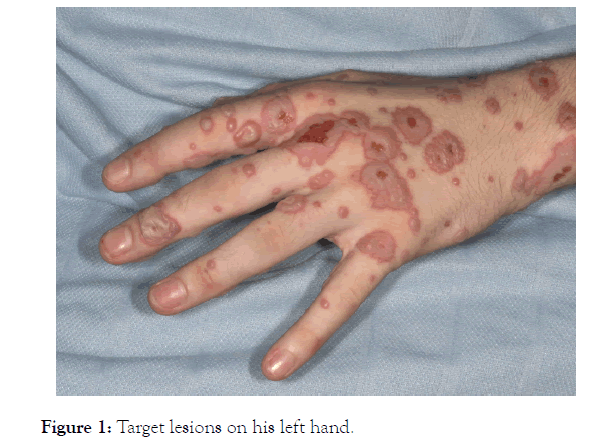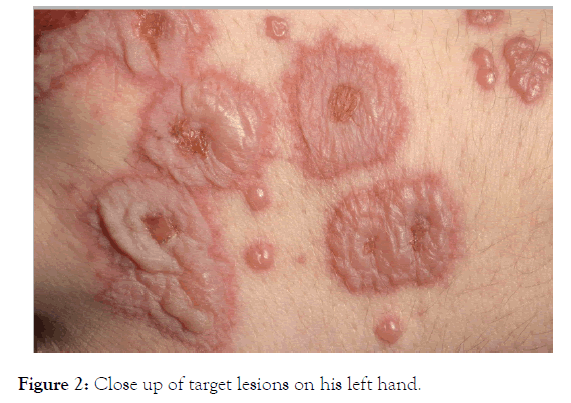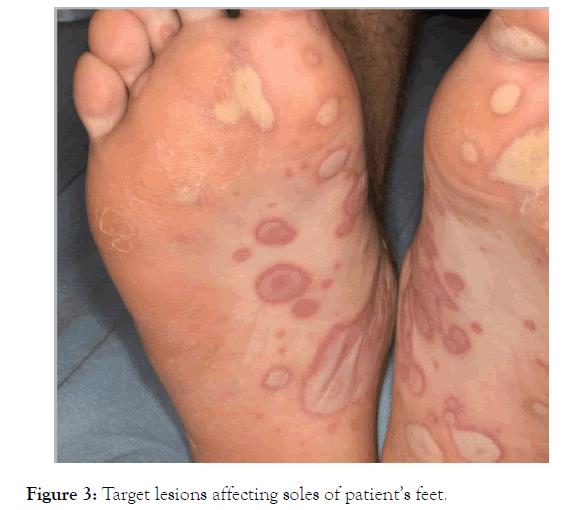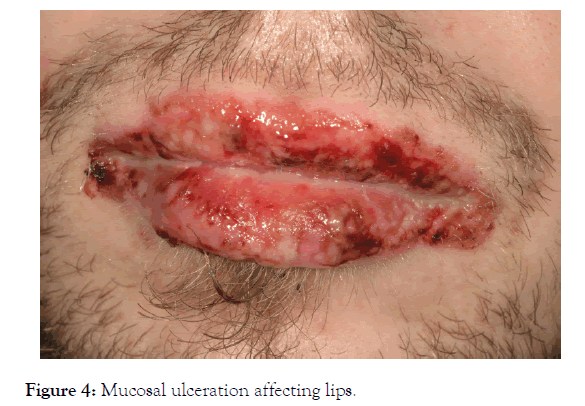Journal of Clinical & Experimental Dermatology Research
Open Access
ISSN: 2155-9554
ISSN: 2155-9554
Case Report - (2019)Volume 10, Issue 5
Erythema multiforme major (EMM) is a severe hypersensitivity skin reaction that is potentially life threatening. We present a case report of a gentleman who presented with EMM induced by Lysergic acid diethylamide. The case aims to raise awareness and highlights the importance of taking a comprehensive drug history including recreational drug use. This is especially important in the face of rising recreational drug usage rates.
Erythema; Lysergic acid diethylamide, Tachycardia
Erythema multiforme (EM) is an acute hypersensitivity reaction to an infection or drug that is usually self-limiting and tends to occur in adults aged 20 to 40 years with a male predominance. It is characterised by a sudden polymorphous eruption of macules, papules and target lesions which can number from a few, to several hundreds. EM tends to develop symmetrically over the dorsum of the hands and feet before spreading proximally [1,2].
Erythema multiforme major is a rare but severe subtype of EM with similar skin features but can additionally affect one or more mucosal membranes and can be associated with fever and joint pain.
The most common cause of EMM is infection, with medications being an uncommon cause for EMM. Reported causative drugs include penicillins, non-steroidal anti-inflammatory drugs, sulphonamides and barbiturates [3].
Lysergic acid diethylamide (LSD) is a hallucinogenic drug that works by activating serotonin receptors - mainly 5HT2A receptors. It was first made in 1938 by Alfred Hoffman and was initially trialed as a treatment for various psychiatric conditions. This was stopped and regulated as a controlled drug in 1971 due to its harmful side effects. LSD has no license for medical treatment currently. Instead it is now used as a substance of abuse for its hallucinogenic properties [4].
We present a case of a 22 year old male who developed EMM after taking the recreational drug LSD and we believe this is the first case in the literature to report this.
A 22 year old Latvian warehouse operator with no past medical history, presented with a five day history of a progressive erythematous, pruritic skin eruption that initially developed on his limbs and a three day history of blistering oral lesions involving the tongue, buccal membranes and hard palate. He also had haemorrhagic crusting of his lips causing difficulty swallowing and speaking due to pain.
He took no regular prescribed medications, denied taking any over the counter medications and did not have any allergies. Our patient also did not have any coryzal symptoms in the days leading up to his rash.
On initial assessment he was febrile and tachycardic. He was admitted under the medical team and was febrile and tachycardic. During his admission he had several episodes of diaphoresis and anxiety. Admission blood tests revealed a mildly elevated white cell count of 10.9 and raised inflammatory markers, with a C-reactive protein of 167. Renal and liver functions were normal.
Our patient was then referred to the dermatology team with a query of erythema multiforme and had already been started on antibiotics, antivirals and analgesia.
On examination by the dermatology team, the patient had well defined, round-shaped lesions with three concentric colours: a central dusky red centre, which can sometimes crust or blister; a paler pink area due to oedema; and an outermost red ring. Clinically, these were diagnosed as target lesions and were predominantly over his palms, arms, legs and soles (Figures 1 and 2).

Figure 1. Target lesions on his left hand.

Figure 2. Close up of target lesions on his left hand.
There was also severe mucosal ulceration affecting the lips, buccal and palatal mucosa causing problems with oral intake (Figures 3 and 4). Numerous investigations were carried out with infective screens, including bacterial and viral being negative. An autoimmune screen was also negative.

Figure 3. Target lesions affecting soles of patient’s feet.

Figure 4. Mucosal ulceration affecting lips.
The initial management plan consisted of supportive management, with analgesia provided, topical emollients and topical potent steroids on the target lesions. However, our patient’s condition began to deteriorate, with the oral lesions becoming ulcerated causing significant pain. Active management was started with oral steroids (prednisolone 30 mg) and steroid mouthwash. Intravenous fluids were also given due to reduced oral intake. The patient improved significantly over the week with complete resolution of his skin lesions and the ulceration in his mouth had healed.
The patient was asked on admission if he had taken any medications or over the counter medications which he denied. He was then asked if he had taken any recreational drugs and admitted to have taken LSD tablets. He reported to have first tried LSD two weeks previously and then again one week before his skin eruption. He denied having taken LSD previously but admitted to cannabis use in the past with no skin issues.
He was strongly advised to avoid taking any recreational drugs and a follow up appointment was arranged for 4 weeks. Our patient failed to attend his follow up appointment.
EMM is a clinical diagnosis and is characterised by typical target lesions in an acral pattern with involvement of one or more mucous membranes. In its most severe form, it can progress to blistering [1], which it did in our reported case. In the majority of cases no treatment is required as the rash settles by itself. Treatment is usually directed to any possible cause, antibiotics and antivirals for bacterial and viral triggers respectively. If a drug cause is suspected then the offending drug should be ceased. The role of oral corticosteroids remains controversial as no controlled studies have shown any benefit. However for severe disease oral prednisolone at 0.5-1 mg/kg/day can be used early in the disease process [5]. There are no current reports of EMM induced by LSD.
According to the trends in illicit drug use measured by the 2017/18 Crime Survey for England and Wales, around 1 in 11 adults aged 16 to 59 have taken a recreational drug in the last year. In addition, the use of LSD in this age group has risen by 47,000 more people than the previous year [6]. With the increasing use of recreational drugs among adults, it becomes important to raise awareness of the potential life threatening reactions that can occur with intake.
In summary, we report a case of EMM induced by LSD and the importance of taking a comprehensive drug history, including recreational drug use.
Citation: Chan SY, Hussain K, Soon C (2019) Erythema Multiforme Major Induced by Lysergic Acid Diethylamide. J Clin Exp Dermatol Res. 10: 5. Doi: 10.35248/2155-9554.19.10.509
Received: 03-Oct-2019 Accepted: 10-Oct-2019 Published: 17-Oct-2019 , DOI: 10.35248/2155-9554.19.10.509
Copyright: © 2019 Chan SY. This is an open-access article distributed under the terms of the Creative Commons Attribution License, which permits unrestricted use, distribution, and reproduction in any medium, provided the original author and source are credited.